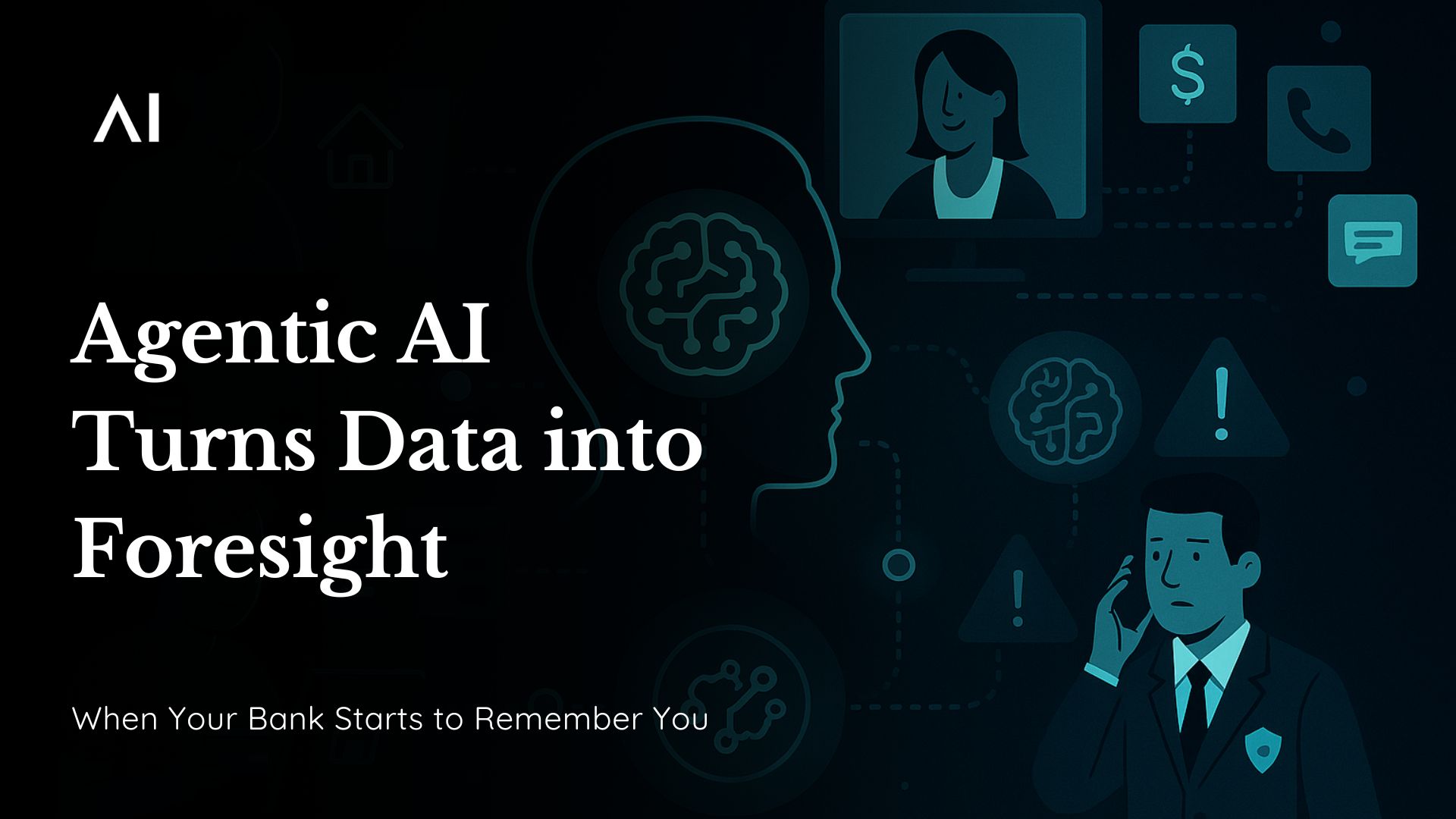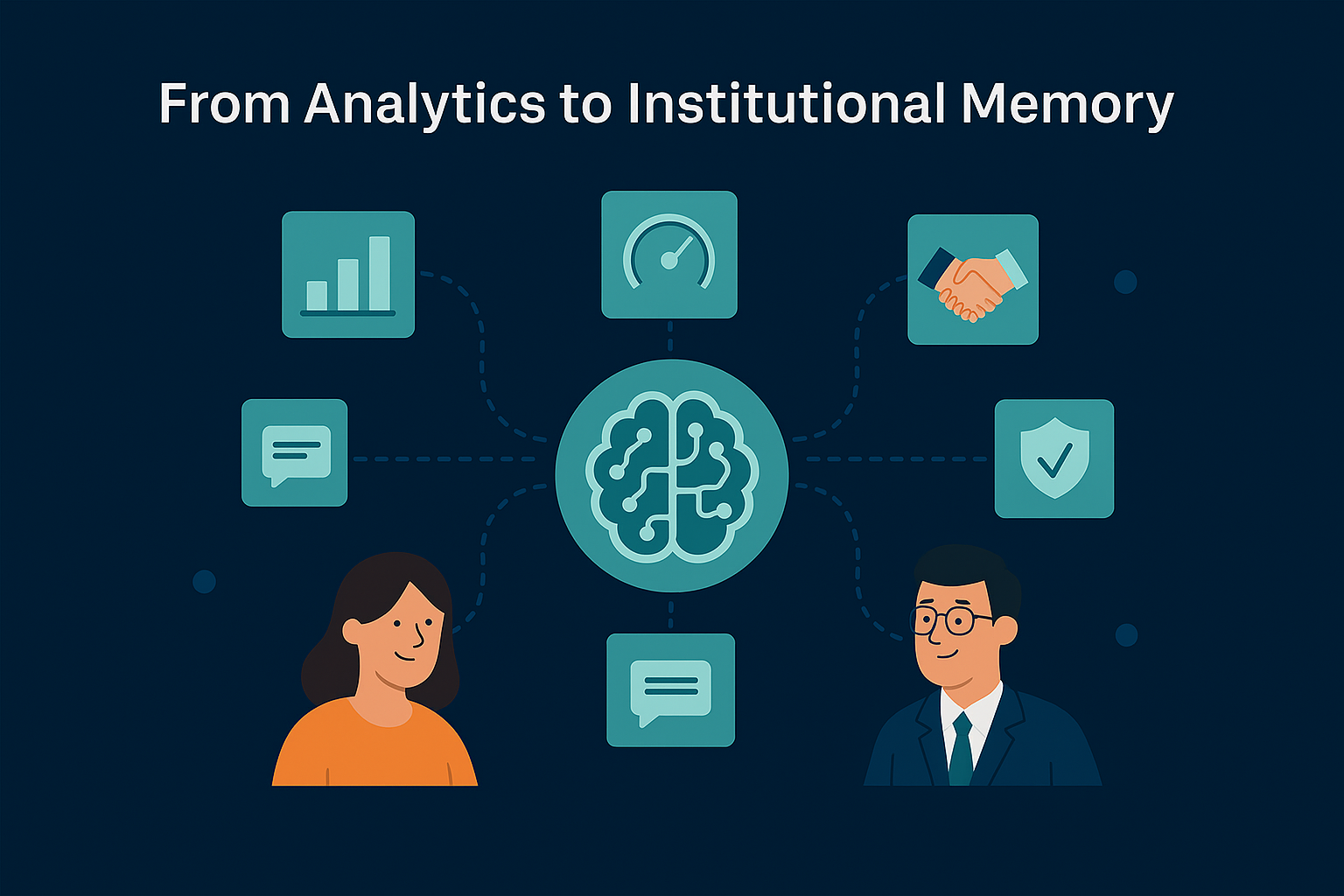Join our WhatsApp Community
AI-powered WhatsApp community for insights, support, and real-time collaboration.
Discover how Agentic AI with memory transforms banking from reactive automation to intelligent foresight — building the Thinking Bank of the future.

| Why is AI important in the banking sector? | The shift from traditional in-person banking to online and mobile platforms has increased customer demand for instant, personalized service. |
| AI Virtual Assistants in Focus: | Banks are investing in AI-driven virtual assistants to create hyper-personalised, real-time solutions that improve customer experiences. |
| What is the top challenge of using AI in banking? | Inefficiencies like higher Average Handling Time (AHT), lack of real-time data, and limited personalization hinder existing customer service strategies. |
| Limits of Traditional Automation: | Automated systems need more nuanced queries, making them less effective for high-value customers with complex needs. |
| What are the benefits of AI chatbots in Banking? | AI virtual assistants enhance efficiency, reduce operational costs, and empower CSRs by handling repetitive tasks and offering personalized interactions. |
| Future Outlook of AI-enabled Virtual Assistants: | AI will transform the role of CSRs into more strategic, relationship-focused positions while continuing to elevate the customer experience in banking. |
Every bank today is sitting on oceans of data — yet most of it behaves like sand: it slips through the cracks after every interaction.
Your chatbot forgets yesterday’s frustration. Your risk engine forgets context. Your CRM stores notes that no one ever reads.
Now imagine if your systems could remember like people do — not just the data, but the story behind it.
That’s what Agentic AI with memory unlocks.
It’s not simply an algorithm that predicts or classifies; it’s a network of intelligent agents that learn continuously, reason contextually, and act autonomously.
If you’d like to understand how memory itself is reshaping enterprise AI, check out our detailed post on The Rise of Memory-Enabled AI.
When your bank starts to remember, you stop reacting to problems — and start anticipating them.
Here’s the real shift:
Traditional AI helps banks look at the past.
Agentic AI helps them act on the future.
The difference lies in memory persistence.
An Agentic system doesn’t treat every query as new. It connects what it already knows — behavior patterns, sentiment, previous complaints, spending histories — and builds reasoning layers on top of that context.
That’s foresight.
It’s how the system moves from “What happened?” to “What happens next — and what should we do about it?”
Agentic AI runs on a continuous cycle: Perceive → Remember → Reason → Act → Learn.
In a banking environment, that means:
This loop turns AI from a static feature into a living ecosystem of autonomous agents collaborating across functions.
To see how large language models power these agents and coordinate reasoning across workflows, read our explainer on LLM-Powered AI Agents.
True personalization in banking isn’t about using your first name in an email.
It’s about anticipating needs before customers voice them.
Memory-driven Agentic AI makes that possible.
Picture this:
A customer explores mortgage calculators on your site, then pauses transactions for a few weeks.
Later, your AI notices recurring property-related searches in their app activity.
The system connects the dots — this user is preparing to buy a home.
Without a prompt, the Customer Engagement Agent can:
That’s not marketing automation.
That’s contextual reasoning at scale — where AI doesn’t just remember behavior but infers intent.
Conventional risk systems rely on static thresholds and historical models. They react after deviations.
Agentic AI operates differently. It uses memory to build behavioral baselines that evolve per customer.
If a credit card user suddenly withdraws large sums abroad, the AI checks memory:
If yes — no alert needed.
If not — it quietly reduces exposure, flags anomaly, and notifies a Risk Agent to act.
No panic, no false positives, just intelligent foresight.
Over time, the AI learns which behaviors precede genuine fraud or delinquency, creating a self-optimizing risk perimeter that improves continuously — without waiting for model retraining cycles.

Churn prediction used to be a dashboard metric.
Now, with Agentic AI, it becomes an action loop.
Each interaction — a late response, a complaint tone, a missed payment — enriches memory.
When the system senses early friction, it doesn’t wait for survey data.
It triggers the Retention Agent:
This is how banks move from reactive recovery to preemptive loyalty building.
Imagine your bank as a living organism:
They operate independently but share one persistent memory layer — a Collective Intelligence Fabric.
When the Voice Agent detects stress in tone, the Risk Agent might slow automated collection reminders.
When the CRM Agent notes a birthday, the Engagement Agent adjusts campaign offers.
Every agent contributes to — and learns from — the same contextual memory.
That’s what transforms siloed banking into coordinated intelligence.
For deeper examples of how financial institutions are deploying this architecture, explore our section on AI in Banking & Finance.
For regulated institutions, remembering responsibly matters as much as remembering accurately.
Agentic AI must operate within strict governance:
Fluid AI’s architecture builds these safeguards into the foundation — combining encryption, access control, and transparent logs.
The result: autonomy with accountability.
Banks already invest millions in analytics platforms.
What’s missing is continuity.
Agentic AI adds the missing layer: working memory that connects analytics with action.
Instead of static reports, you get a live intelligence system that learns from every transaction, every complaint, every resolved ticket — and uses that to improve the next decision.
That’s not automation. That’s evolution.
When memory becomes shared across departments, your institution begins to operate as a single intelligent organism — always learning, always improving.
The banking world has reached automation saturation.
Everyone has bots. Everyone has RPA. Everyone has dashboards.
The next differentiator isn’t speed. It’s understanding.
Agentic AI offers a direct path to:
In numbers, early adopters of Agentic AI platforms are seeing:
This isn’t speculative tech — it’s the operational edge being deployed right now.

At Fluid AI, we design Agentic ecosystems that give banks memory, reasoning, and autonomy — without disrupting legacy cores.
Our platform integrates with existing CRMs, data lakes, and compliance frameworks to deploy:
The outcome:
Banks transition from data-rich but insight-poor to memory-driven and foresight-ready.
That’s what it means to turn intelligence into value.
When your bank starts to remember, everything changes.
Decisions get faster. Experiences feel personal. Risks surface before they turn costly.
Agentic AI doesn’t replace your workforce — it augments institutional intelligence, embedding foresight into daily operations.
The next wave of banking transformation won’t be about digital channels or automation — it’ll be about banks that think, learn, and remember.
And that’s exactly what Fluid AI is building.
Fluid AI is an AI company based in Mumbai. We help organizations kickstart their AI journey. If you’re seeking a solution for your organization to enhance customer support, boost employee productivity and make the most of your organization’s data, look no further.
Take the first step on this exciting journey by booking a Free Discovery Call with us today and let us help you make your organization future-ready and unlock the full potential of AI for your organization.

AI-powered WhatsApp community for insights, support, and real-time collaboration.
.webp)
.webp)

Join leading businesses using the
Agentic AI Platform to drive efficiency, innovation, and growth.
AI-powered WhatsApp community for insights, support, and real-time collaboration.